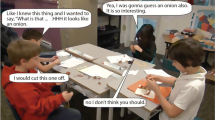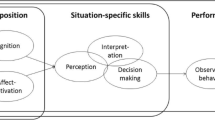Abstract
In this review essay I respond to issues raised in Mijung Kim and Wolff-Michael Roth’s paper titled “Dialogical argumentation in elementary science classrooms”, which presents a study dealing with dialogical argumentation in early elementary school classrooms. Since there is very limited research on lower primary school students’ argumentation in school science, their paper makes a contribution to research on children’s argumentation skills. In this response, I focus on two main issues to extend the discussion in Kim and Roth’s paper: (a) methodological issues including conducting a quantitative study on children’s argumentation levels and focusing on children’s written argumentation in addition to their dialogical argumentation, and (b) investigating children’s conceptual understanding along with their argumentation levels. Kim and Roth emphasize the difficulty in determining the level of children’s argumentation through the Toulmin’s Argument Pattern and lack of high level arguments by children due to their difficulties in writing texts. Regarding these methodological issues, I suggest designing quantitative research on coding children’s argument levels because such research could potentially provide important findings on children’s argumentation. Furthermore, I discuss alternative written products including posters, figures, or pictures generated by children in order to trace children’s arguments, and finally articulating argumentation and conceptual understanding of children.
Similar content being viewed by others
Avoid common mistakes on your manuscript.
Kim and Roth’s paper presents a study dealing with dialogical argumentation in early elementary school classrooms. The authors criticize Toulmin’s Argument Pattern (1958) as an analytic approach because of the deficiency in addressing the dynamics of epistemic criteria of children’s reasoning and decision-making in dialogical situations. That is why they draw on the social-psychological theory of L. S. Vygotsky to investigate the genesis of evidence-related practices in second- and third-grade children. They use a descriptive case study focusing on children’s dialogical argumentation in one classroom setting without any intervention. Since there is limited research on lower primary school students’ argumentation in school science, Kim and Roth’s paper makes a contribution to research on children’s argumentation skills. In this paper, I focus on two main issues to extend the discussion in Kim and Roth’s paper: (a) methodological issues including conducting a quantitative study on children’s argumentation levels and focusing on children’s written argumentation in addition to their dialogical argumentation, and (b) investigating children’s conceptual understanding along with their argumentation levels.
Broadening methodological approaches in argumentation
Kim and Roth designed their research as a descriptive case study which uses qualitative research methods. They focus on how claim and evidence emerge from children’s interactions and how the shift of burden of proof takes place between arguers. They investigate children’s argumentation by analyzing the video recordings of children’s dialogues in two lessons. The authors emphasize the limitations of a case study on the objectivity and generalizability of findings from one single unit. Even if the authors emphasize the difficulty in determining the level of children’s argumentation, it is essential to design research on coding children’s argument levels because such research could potentially provide important findings on children’s argumentation. The argument levels can be investigated through quantitative research design (e.g. Cetin 2014; Kaya 2013). Thus, quantitative methodology in addition to qualitative can be conducted to understand children’s arguments in a more detailed way. Understanding children’s argumentation levels would provide some implications for teaching and learning science in the early grade science education.
The authors state that “many studies on argumentation adapted Toulmin’s argumentation patterns (TAP) to develop and analyze students’ understandings of argumentation structures and levels of reasoning. Toulmin’s model provides a description of the major components of argumentation that includes claims, grounds, warrants (linking grounds to claims), backing for warrants, rebuttals, and modal qualifiers (e.g., most, probably, possibly) (Toulmin 1958)”. Indeed, many researchers have applied TAP as a methodological tool for the analysis of argumentation in science education (e.g. Erduran, Simon, & Osborne 2004; Jimenez-Aleixandre, Rodriguez, & Duschl 2000; Venville and Dawson 2010). Erduran, Simon, & Osborne (2004) indicated the potential of TAP for qualitative and quantitative investigation of argumentation in science lessons. They applied TAP to find out particular patterns in the distribution of TAP clusters as a qualitative indicator and to make statistical comparison of TAP cluster frequencies as a quantitative indicator. Thus, they traced the quantity and quality of argumentation in science discourse. By so doing, they analyzed argumentation discourse in a broader way. In this sense, Kim and Roth’s paper can be extended by conducting a quantitative study on children’s argumentation by applying TAP.
A further issue I would like to emphasize is the way children generate their arguments: dialogical argumentation versus written argumentation. Kim and Roth indicate that “in science education, researchers have attempted to understand students’ argumentation skills through various applications of argumentation in conversational and written arguments (Kelly and Takao 2002)”. They again underline TAP as an approach used to analyze written and dialogical arguments in classroom discourse. They further state that “analyzing with TAP schemes and any analytical models for high-level writing skills might not sufficiently explain how children learn to evaluate evidence, persuade and are convinced by others, and reach conclusions when their ideas are challenged in the classroom, especially younger children in elementary schools”. Regarding children’s learning to convince each other, we can think about possible ways of teaching children to evaluate evidence and of convincing their peers by presenting more evidence themselves. Furthermore, the authors make reference to Maloney and Simon’s (2006) study on argumentation among 10–11-year-old children, in which it was found that coding and counting claims and evidence did not show the level of children’s argumentation skills effectively since students repeated the same claims and evidence several times. If the problem is children’s lack of constructing high level arguments including the use of warrant, backing, rebuttal, we need to think about how we can teach all these components of a high quality argument in science lessons. By citing Sandoval and Millwood (2007) the authors advance the position that children would need certain levels of content knowledge and language skills to construct high levels of argumentation. If the problem is children’s difficulties in writing texts including grammatical issues, we can focus on their other products. These products might be posters, figures, or pictures. Thus, we can support our findings by focusing on data on children’s drawings besides their verbal dialogical argumentation.
Articulating argumentation and conceptual understanding
Kim and Roth investigate the emergence of argumentation patterns and burden of proof procedures from societal-historical psychology perspective. They specifically examine children’s argumentation as social relations by investigating the genesis of evidence-related practices (especially burden of proof) in second- and third-grade children. Their study reports on how participating in classroom talk leads to the genesis of children’s reasoning and argumentation in and through classroom talk; and it exemplifies how teachers play a significant role in the emergence of universally valid (scientific) argumentation. The authors use some example materials from classroom sessions where second- and third-grade children were engaged in finding out the nature of a mystery object in a unit on plants. It was reported that the unit on plants which is included in the science curriculum covers the structure of plants, the functions of different parts of plants, light and photosynthesis, soil and water, seeds and roots, soil, and living things in the soil. Kim and Roth only focus on the emergence of argumentation patterns and burden of proof procedures in children’s talk.
Given the rich context of science concepts, it is surprising that the authors have not addressed children’s conceptual understanding. The articulation of argumentation and conceptual understanding is a significant area in science education research. There is substantial research addressing the effectiveness of argumentation on students’ conceptual understanding of scientific concepts (Driver, Newton, & Osborne 2000; Jimenez-Aleixandre and Pereiro-Munhoz 2002; Venville and Dawson 2010; Zohar & Nemet 2002). Driver, Newton, & Osborne (2000) address that argumentation has an important role in developing conceptual understanding Therefore, to report the implications for children’s conceptual understanding of subject knowledge in an argumentative discourse would also make contribution to science education research on children’s argumentation. How is the context of this study related to improving children’s conceptual understanding? Indeed, what do the authors expect the children to learn as conceptual outcomes as a result of engagement in argumentation? Such questions remain unclear in the paper. Kim and Roth could extend the paper by considering the questions which are about the articulation of argumentation and conceptual understanding.
References
Cetin, P. S. (2014). Explicit argumentation instruction to facilitate conceptual understanding and argumentation skills. Research in Science & Technological Education, 32(1), 1–20.
Driver, R., Newton, P., & Osborne, J. (2000). Establishing the norms of scientic argumentation in classrooms. Science Education, 84, 287–312.
Erduran, S., Simon, S., & Osborne, J. (2004). TAPping into argumentation: Developments in the application of Toulmin’s argument pattern for studying science discourse. Science Education, 88(6), 915–933.
Jimenez-Aleixandre, M. P., & Pereiro-Munhoz, C. (2002). Knowledge producers or knowledge consumers? Argumentation and decision making about environmental management. International Journal of Science Education, 24(11), 1171–1190.
Jimenez-Aleixandre, M., Rodriguez, A., & Duschl, R. (2000). ‘Doing the lesson’ or ‘doing science’: Argument in high school genetics. Science Education, 84(6), 757–792.
Kaya, E. (2013). Argumentation practices in classroom: Pre-service teachers’ conceptual understanding of chemical equilibrium. International Journal of Science Education, 35(7), 1139–1158.
Kelly, G. J., & Takao, A. (2002). Epistemic levels in argument: An analysis of university oceanography students’ use of evidence in writing. Science Education, 86, 314–342.
Maloney, J., & Simon, S. (2006). Mapping children’s discussions of evidence in science to assess collaboration and argumentation. International Journal of Science Education, 28(15), 1817–1841.
Sandoval, W., & Millwood, K. (2007). What can argumentation tell us about epistemology? In S. Erduran & M. P. Jiménez-Aleixandre (Eds.), Argumentation in science education: Perspectives from classroom-based research (pp. 71–88). Dordrecht: Springer.
Toulmin, S. (1958). The uses of argument. Cambridge: Cambridge University Press.
Venville, G. J., & Dawson, V. M. (2010). The impact of a classroom intervention on grade 10 students’ argumentation skills, informal reasoning, and conceptual understanding of science. Journal of Research in Science Teaching, 47(8), 952–977.
Zohar, A., & Nemet, F. (2002). Fostering students’ knowledge and argumentation skills through dilemmas in human genetics. Journal of Research in Science Teaching, 39(1), 35–62.
Author information
Authors and Affiliations
Corresponding author
Additional information
Lead Editor: Kamini Jaipal-Jamani.
This review essay addresses issues raised in Mijung Kim and Wolff-Michael Roth’s paper (this issue) entitled Dialogical argumentation in elementary science classrooms. doi:10.1007/s11422-017-9846-9.
Rights and permissions
About this article
Cite this article
Kaya, E. Argumentation in elementary science education: addressing methodological issues and conceptual understanding. Cult Stud of Sci Educ 13, 1087–1090 (2018). https://doi.org/10.1007/s11422-017-9848-7
Received:
Accepted:
Published:
Issue Date:
DOI: https://doi.org/10.1007/s11422-017-9848-7




